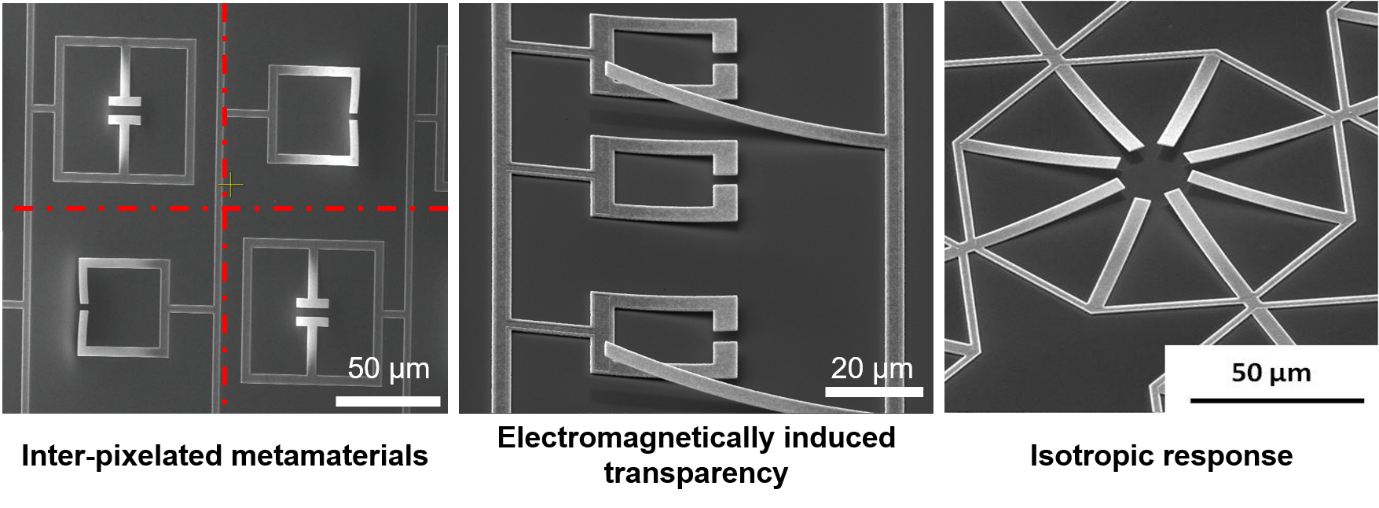Electromagnetic metamaterial is a periodic array of sub-wavelength artificial structures that can achieve unique electromagnetic properties. These include negative refractive index, perfect absorption, wavelength selective absorption, and many more. The properties of the metamaterials are strongly dependent on the geometry of their unit cell, and thereby through engineering of the size and shape of the unit cell, a precise control of the metamaterial properties can be readily achieved. Metamaterials and their ability to manipulate EM property is extremely scalable to any spectrum region, and thus use of metamaterial is a promising solution for efficient control of the THz wave. Typical wavelength of THz wave ranges from 30 µm to 3 mm. Hence sub-wavelength of the THz wave is in the order of tens micron, which has great compatibility with the microelectromechanical systems (MEMS) technology. MEMS technology has enable realization and commercialization of many types of sensor, actuator and systems with reduced size and improved performance. Evolved from the integrated-circuit (IC) industry, MEMS allows for device fabrication using not only silicon (Si) but also glass, ceramics, metal, and flexible polymer. This allows for advance fabrication of metamaterial device in the THz region. Currently our group is focusing on tunable MEMS metamaterials, and MEMS metamaterials sensors.
We have developed and reported MEMS based tunable metamaterial in the terahertz region by simple electrostatic actuation. Bimorph structure of Al/Al2O3 are fabricated on Si substrate using CMOS compatible process, and a SiO¬2 sacrificial layer beneath allows for partial suspension of micro-cantilever at designed region after releasing process. The residual stress between Al and Al2O3 results in bending at the released part. These suspended micro-cantilever can be actuated through applying voltage between the top Al layer and the lightly doped Si substrates at the bottom. As a result the micro-cantilever move toward the substrates due to the generated attractive force. This actuation of cantilever lead to dynamic tunability of each metamaterial unit cell through simple electrostatic method. With this electrostatically actuated stressed beam technology, various sophisticated applications has been reported in our group. These include inter-pixelated metamaterial control, active control of electromagnetically induced transparency and its excitation pathway, isotropy and anisotropy response, and THz filter. As a future work, we will explore the possibility of achieving multilayer, multiple pixel metamaterial devices in order to realize 3D metamaterial structures using MEMS fabrication techniques.

Selected Publications:
1. Prakash Pitchappa, Chong Pei Ho, Lokesh Dhakar and Chengkuo Lee, Microelectromechanically reconfigurable interpixelated metamaterial for independent tuning of multiple resonances at terahertz spectral region,, Optica, vol. 2, no. 6, pp. 571-578, 2015.
2. Manukumara Manjappa, Chong Pei Ho, Ranjan Singh, Navab Singh and Chengkuo Lee, Active control of electromagnetically induced transparency analogue in terahertz MEMS metamaterial, Adv. Opt. Mater., vol. 4, no. 4, pp. 541-547, 2016.
3. Prakash Pitchappa, Chong Pei Ho, You Qian, Lokesh Dhakar, Navab Singh and Chengkuo Lee, Microelectromechanically tunable multiband metamaterial with preserved isotropy,, Sci. Rep., vol. 5, no. 11678, pp. 1-10, 2015.
Terahertz response of the metamaterials highly depend on the surrounding medium of the metasurface. We have employed liquid crystals as the surrounding medium which can take advantage of their large birefringence property, and cause shifts in the resonant frequency upon application of electric or magnetic field. One of the reported work fabricated a metasurface of split ring resonator (SRR) array on PET substrates. A liquid crystal cell was formed by two inward-facing indium tin oxide (ITO)-coated PET which offers flexible and transparent conductivity. The ability to vary the refractive index of the liquid crystal with the applied voltage shows an enhancement of the SRR resonance. The SRR is also known for its confined electrical field at the gap region, where the change in the gap capacitance greatly affect the resonance frequency. We have integrated microfluidic single particle trapping structure with terahertz metamaterials as a selective particle sensor. The trapping of particle at the gap region of each SRR allows for sensitive detection of micro-substances using THz-TDS (THz-time domain spectroscopy). As a future work, we will explore the potential of metamaterials in the THz region for bio-chemical sensing.

Selected Publications:
1. Zhen Liu, Chia-Yi Huang, Hongwei Liu, Xinhai Zhang and Chengkuo Lee, Resonance enhancement of terahertz metamaterials by liquid crystals/indium tin oxide interfaces,, Optics Express, vol. 21, no. 5, pp. 6519-6525, 2013.
2. Kailing Shih, Prakash Pitchappa, Manukumara Manjappa, Chong Pei Ho, Ranjan Singh and Chengkuo Lee, Microfluidic Metamaterial Sensor (MMS): Selective trapping and remote sensing of microparticles, J. Appl. Phys., vol.121, no. 2, pp. 023102, 2017.
